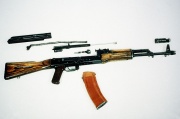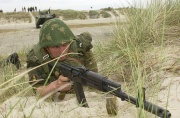AK-74
| |||||||||||||||||||||||||||||||||||||||||||||||||||||||||||||
The AK-74 is a 5.45 mm assault rifle developed in the early 1970s in the Soviet Union by Mikhail Kalashnikov. It was developed from the earlier AKM. It was introduced in 1974 and first saw service with Soviet forces engaged in the Soviet war in Afghanistan. The weapon’s name is an abbreviation for Avtomat Kalashnikova Model 1974 (Russian: Автомат Калашникова образца 1974 года or "automatic rifle Kalashnikov model of 1974"). Currently the weapon is in use by the majority of countries of the former USSR. Additionally, unlicensed versions were produced in Bulgaria (AK-74 and AKS-74U), China (Type 88), the former East Germany (MPi-AK-74N, MPi-AKS-74N, MPi-AKS-74NK), Poland (wz. 1988 Tantal, wz. 1989 Onyks) and Romania (PA md. 86).
Contents |
[edit] Design
The AK-74 is an adaptation of the 7.62 mm AKM assault rifle and features several notable design improvements. These modifications were primarily the result of adapting the weapon to the intermediate-caliber 5.45x39mm cartridge. The result is a more accurate weapon than the AKM.[1] The AK-74 and AKM share an approximate 50% parts commonality (interchangeable most often are pins, springs and screws).
The rifle received a new reinforced barrel[1] with a chrome-lined bore and 4 right-hand grooves at a 200 mm (1:8 in) rifling twist rate. The front sight base and gas block were also redesigned.
The gas block contains a gas channel that is installed at a 90° angle in relation to the bore axis. A pair of support brackets are cast into the gas block assembly and are used to attach a BG-15 or GP-25 under-slung 40 mm grenade launcher. The forward section of the front sight base features a threaded collar that is used to screw in the new multifunction muzzle device (performing the role of a muzzle brake, recoil compensator and flash suppressor) or a blank-firing adaptor. The muzzle device is quite efficient at reducing recoil and muzzle jump, although it is reported to be harsh on bystanders, as the muzzle gases are redirected to the sides.[2] The barrel is mounted in a redesigned receiver housing (changes to the receiver include the front barrel and rear stock trunnions as well as the magazine socket). Further modifications were done to the bolt carrier assembly and bolt; new synthetic 30-round magazines were introduced, made initially from Bakelite and later – polymer. The magazines can be quickly recharged from stripper clips.
The AK-74 was also equipped with a new stock, handguard and gas cylinder. The stock has a different shoulder pad than the AKM, which is rubber and serrated for increased traction. In addition, there are weight-reducing lightening cuts on each side of the buttstock. These also function to distinguish externally by sight and touch between the AKM and the AK-74, to prevent the accidental loading of the wrong ammunition in an AK-74.
The handguard and gas cylinder are both fitted with tension springs that reduce play in the lateral axis. The stock, lower handguard and upper heatguard were initially manufactured from wood and then laminated, this later changed to a synthetic plum and then a black-colored polymer.
Accessories supplied with the rifle include a 6H4-type bayonet, a quick-loading device, three spare magazines, four 15-round stripper clips, maintenance kit, cleaning rod and sling. The bayonet is installed by slipping the muzzle ring around the flash hider and latching the handle down on the bayonet lug under the front sight base. The weapon fires the intermediate 5.45x39mm M74 rifle ammunition that includes the jacketed, steel-core 7N6 bullet, 7T3 tracer round and a blank cartridge. The ammunition was developed by a team of designers led by Victor Sabelnikov.
The weapon’s operation during firing and reloading is identical to the AKM.[1]
[edit] Variants
One of the rifle’s main versions is the AKS-74 (S – So skladnym prikladom) equipped with a side-folding metal stock. This variant, designed mainly for use with air assault infantry was introduced alongside the AK-74. Unlike the AKMS, the AKS-74 stock has a triangular shape and lacks the folding shoulder pad of the AKMS (which increases the stock’s rigidity) and is folded to the left side of the receiver. The hinged stock is securely locked in place in its extended position by a latch mechanism at the rear of the receiver. The latch release button is located on the left side of the receiver. When folded, the stock is held by a spring-loaded capture in the forward barrel trunnion. A rear sling swivel is also provided and placed on the right side of the lower stock frame.
In 1979 a shortened variant of the AKS-74 was adopted into service – the AKS-74U (U – Ukorochenniy) carbine, which in terms of tactical deployment, bridges the gap between a submachine gun and assault rifle. It is intended for use mainly with special forces, airborne infantry, rear-echelon support units and armored vehicle crews. The weapon’s compact dimensions, compared to the AKS-74, were achieved by using a short, 210 mm (8.3 in) barrel (this forced designers to simultaneously reduce the gas piston operating rod to an appropriate length). In order to effectively stabilize projectiles, the barrel’s twist rate was increased from 200 mm (1:8 in) to 160 mm (1:6.3 in). A new gas block was installed at the muzzle end of the barrel and a new conical flash hider was used, which features an internal expansion chamber that alleviates gas pressure generated during firing. The flash suppressor locks into the gas block with a latch placed on the right side. The forward sling loop was relocated to the left side. The weapon’s front sight is integrated into the gas block.
The AKS-74U also has a different sight system arrangement with a U-shaped flip sight instead of the standard sliding notch sight. The rear sight has two settings: “P” (fixed for firing at 350 m) and “4-5” (used for firing at distances up to 400–500 m). The rear sight is housed in a semi-hooded shroud that is riveted to the receiver top cover. This top cover is connected with the gas tube cover and is hinged, pivoting forward when opened. Both the gas tube and handguard are also of a new type and are shorter than analogous parts in the AKS-74.
The AKS-74U is significantly more maneuverable in tight quarters than the AKS-74, however the steep decline in muzzle velocity from 900 m/s (2,952.8 ft/s) to 735 m/s (2,411.4 ft/s) resulted in a decrease in effective aimed range (the effective hitting distance for a “running”-type silhouette was reduced from 625 to 350 m).[1] The carbine cannot mount a bayonet or standard under-barrel grenade launcher. However, a suppressed 30 mm BS-1 grenade launcher was developed for this weapon that fires high-explosive dual purpose (HEDP) grenades. The grenades from the BS-1 are launched by blank cartridges and the weapon is cycled manually in this mode of operation. The majority of AKS-74U carbines were manufactured at the Tula Arms Factory rather than Izhmash.
The AK-74 family of weapons are also available in a “night-fighting” configuration equipped with a side-rail used to mount night vision sights (these variants, the AK-74N, AKS-74N and AKS-74UN are used with NSPU and NSPUM sights). The AKS-74UB (B – Bezshumniy) is a specialized variant of the AKS-74U, adapted for silenced use with the PBS-5 sound suppressor (used in conjunction with the subsonic 5.45x39mm US cartridge).
In 1991 the Izhmash factory in the city of Izhevsk began production of an improved variant of the AK-74 – the AK-74M (M – Russian: Модернизированный; Modernizirovanniy or "modernized") assault rifle. Apart from several minor production improvements the rifle also features a new synthetic stock made from a black, glass-filled polyamide that is shaped like the AK-74 fixed stock, but also folds like in the AKS-74. Additionally the AK-74M uses a reinforced muzzle device and dust cover. Each AK-74M is fitted with a side-rail bracket for mounting optics. The AK-74M was going to be adopted by the Soviet Union as the standard service rifle, and has been accepted as the new service rifle of the Russian Federation. Older versions of the AK-74 are also still in Russian service.
The AK-74 was also the basis for the new Russian family of Kalashnikov weapons that consists of: the 5.56 mm AK-101 standard rifle and 5.56 mm AK-102 carbine (both use the NATO-standard 5.56x45mm cartridge), 7.62 mm AK-103 assault rifle and 7.62 mm AK-104 (both chambered for the 7.62x39mm M43 round) and the 5.45 mm AK-105 carbine (adapted to use 5.45x39mm M74 ammunition). The AK-101, 102, 103 and 104 are destined primarily for export, while the AK-105 is slated to replace the AKS-74U with the Russian Armed Forces.
[edit] Users
- Afghanistan: Remaining in national inventories from the Soviet war in Afghanistan.
- Angola: The AK-74M is used by the FAPLA commando battalion.
- Armenia
- Azerbaijan
- Belarus
- Bulgaria
- PRC: Produced as the Type 88 (not currently in service).
- Cuba
- East Germany: MPi-AK-74N, MPi-AKS-74N, MPi-AKS-74NK variants made by the state arsenal (which were withdrawn from service after German reunification).
- Estonia
- Georgia
- Kazakhstan
- Kyrgyzstan
- Latvia
- Lithuania
- Moldova
- Mongolia
- Romania: Locally designed and modified folding stock variant known as the PA md. 86 {Puşcă Automată model 1986) in service with the Romanian Army. Developed and produced by RomArm (Formerly RATMIL: Regia Autonomă pentru Producţia de Tehnică Militară).
- Russia / the former Soviet Union
- Tajikistan
- Turkmenistan
- Ukraine
- Uzbekistan
- Venezuela: Used by the Venezuelan National Guard.
- Vietnam: Used by the Vietnam People's Army naval infantry.
[edit] Resources

This article or section is missing resources, such as diagrams or manual links, and could use more input to fill in the missing bits. You (yes, you!) can help Gunsopedia provide more comprehensive information to our users by using your own knowledge to add to it.
[edit] References
- ↑ 1.0 1.1 1.2 1.3 Woźniak, Ryszard. Encyklopedia najnowszej broni palnej - tom 1 A-F. Bellona. 2001. pp25-29.
- ↑ Hogg, Ian & Weeks, John. Military Small Arms of the 20th Century, 7th Edition Krause Publications. (2000) ISBN 0-87341-824-7.
- (Polish) Woźniak, Ryszard (2001). "p. 25-29", Encyklopedia najnowszej broni palnej - tom 1 A-F. Warsaw, Poland: Bellona. ISBN 83-11-09149-8.
[edit] External links
- Izhmash – manufacturer's website
- Fackler AK-74 terminal ballistics study
- AK-47.net Article on AK-74 variations
- AK-47.net
- Modern Firearms
| "AK-74" is part of a series on the AK-47 and its cousins |
|---|
- Articles missing diagrams
- Articles missing manuals
- AK-47 derivatives
- Kalashnikov derivatives
- Russian firearms
- Izhmash firearms
- 5.45mm firearms
- Select fire firearms
- Rifles
- Russian 5.45mm firearms
- Russian rotating bolt firearms
- Russian rifles
- Izhmash 5.45mm firearms
- Izhmash rifles
- 5.45mm rotating bolt firearms
- 5.45mm rifles
- Assault rifles
- Russian 5.45mm rotating bolt firearms
- Russian 5.45mm rifles
- Russian rotating bolt rifles
- Russian assault rifles
- Izhmash 5.45mm rotating bolt
- Izhmash 5.45mm rifles
- Izhmash rotating bolt rifles
- Izhmash assault rifles
- 5.45mm rotating bolt rifles
- 5.45mm assault rifles
- Rotating bolt assault rifles
- 5.45mm rotating bolt assault rifles
- 5.45mm select fire assault rifles
- Russian rotating bolt assault rifles
- Russian 5.45mm assault rifles
- Russian 5.45mm rotating bolt rifles
- Izhmash rotating bolt assault rifles
- Izhmash 5.45mm assault rifles
- Izhmash 5.45mm rotating bolt rifles
- Russian 5.45mm rotating bolt assault rifles
- Russian 5.45mm rotating bolt select fire rifles
- Izhmash 5.45mm rotating bolt assault rifles
- Russian 5.45mm gas select fire rotating bolt assault rifles
- Soviet firearms
- Soviet 5.45mm firearms
- Soviet rotating bolt firearms
- Soviet rifles
- Soviet 5.45mm rotating bolt firearms
- Soviet 5.45mm rifles
- Soviet rotating bolt rifles
- Soviet assault rifles
- Soviet rotating bolt assault rifles
- Soviet 5.45mm assault rifles
- Soviet 5.45mm rotating bolt rifles
- Soviet 5.45mm rotating bolt assault rifles
- Soviet 5.45mm rotating bolt select fire rifles
- Soviet 5.45mm gas select fire rotating bolt assault rifles




